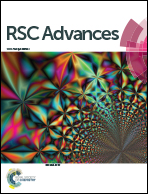Tailoring in vitro biological and mechanical properties of polyvinyl alcohol reinforced with threshold carbon nanotube concentration for improved cellular response
Abstract
The development of living bone tissue constructs with structural, mechanical and functional similarities to natural bone are the major challenges in bone tissue engineering. To overcome these challenges, polyvinyl alcohol–carbon nanotubes (PVA–CNT) nanocomposite scaffolds were developed by varying the CNT concentrations (0, 0.5, 1 and 1.5 wt%) using freeze drying method. The developed scaffolds were characterized for their physicochemical, mechanical and in vitro biological properties. The attachment, proliferation and differentiation of the MG 63 osteoblast cells on the scaffolds were analyzed by scanning electron microscopy (SEM), 3-(4,5-dimethylthiazol-2-yl)-2,5-diphenyltetrazolium bromide (MTT) assay, alkaline phosphatase (ALP) activity assay, alizarin red stain-based (ARS) assay and collagen quantification. The reinforcement of varying concentrations of CNT from 0 to 1 wt% enhanced the mechanical properties of the nanocomposite scaffolds many folds. Amongst all, the scaffold with 1 wt% of CNT provided the most favorable microenvironment for osteoblast cell proliferation and differentiation. The higher CNT concentration (1.5 wt%) had a reduced effect on mechanical properties and in vitro cell growth. From the above studies, it can be concluded that PVA–CNT nanocomposite scaffolds with the relatively low concentration of CNT (1 wt%) are promising biomaterials for acceleration of bone tissue regeneration.


 Please wait while we load your content...
Please wait while we load your content...